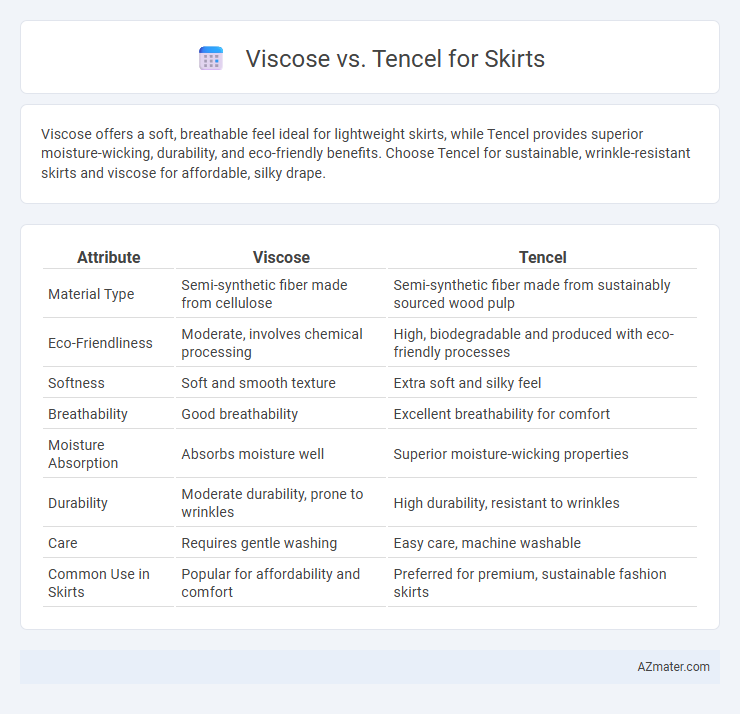Viscose offers a soft, breathable feel ideal for lightweight skirts, while Tencel provides superior moisture-wicking, durability, and eco-friendly benefits. Choose Tencel for sustainable, wrinkle-resistant skirts and viscose for affordable, silky drape.
Table of Comparison
| Attribute | Viscose | Tencel |
|---|---|---|
| Material Type | Semi-synthetic fiber made from cellulose | Semi-synthetic fiber made from sustainably sourced wood pulp |
| Eco-Friendliness | Moderate, involves chemical processing | High, biodegradable and produced with eco-friendly processes |
| Softness | Soft and smooth texture | Extra soft and silky feel |
| Breathability | Good breathability | Excellent breathability for comfort |
| Moisture Absorption | Absorbs moisture well | Superior moisture-wicking properties |
| Durability | Moderate durability, prone to wrinkles | High durability, resistant to wrinkles |
| Care | Requires gentle washing | Easy care, machine washable |
| Common Use in Skirts | Popular for affordability and comfort | Preferred for premium, sustainable fashion skirts |
Introduction to Viscose and Tencel
Viscose and Tencel are popular fabrics used in skirt manufacturing, each with distinct qualities. Viscose, derived from cellulose, offers a smooth texture and excellent drape, making it ideal for flowy skirts. Tencel, a brand name for lyocell fibers, is known for its eco-friendly production, moisture-wicking properties, and durability, providing a sustainable alternative for comfortable, breathable skirts.
What is Viscose?
Viscose is a semi-synthetic fiber made from regenerated cellulose derived primarily from wood pulp, known for its silk-like softness and breathability. It offers excellent drape and moisture-wicking properties, making it a popular choice for lightweight skirts that provide comfort and fluid movement. However, viscose tends to wrinkle easily and may require delicate care to maintain its appearance and durability.
What is Tencel?
Tencel is a branded lyocell fiber made from sustainably sourced wood pulp, primarily from eucalyptus trees, known for its eco-friendly production process using non-toxic solvents that recycle water and chemicals. It offers superior breathability, moisture-wicking properties, and a silky smooth texture, making it ideal for lightweight skirts with enhanced comfort and durability. Compared to viscose, Tencel provides better wrinkle resistance and biodegradability, aligning with sustainable fashion trends and reducing environmental impact.
Environmental Impact: Viscose vs Tencel
Viscose production relies heavily on wood pulp and involves toxic chemicals like carbon disulfide, resulting in significant environmental pollution and high water consumption. Tencel, a branded lyocell fiber from sustainably harvested eucalyptus trees, uses a closed-loop process that recycles over 99% of solvents, reducing emissions and water usage dramatically. Choosing Tencel skirts supports lower ecological footprints with biodegradable properties and responsible forestry practices, while viscose skirts contribute more to deforestation and chemical waste.
Comfort and Wearability for Skirts
Viscose offers a soft, breathable texture ideal for lightweight skirts, providing excellent moisture absorption and a smooth drape that enhances comfort during extended wear. Tencel, made from sustainably sourced eucalyptus fibers, excels in moisture-wicking and temperature regulation, resulting in skirts that remain comfortable and fresh even in warm or humid conditions. Both fabrics support excellent wearability, but Tencel's natural resistance to wrinkles and durability often translates into longer-lasting comfort and a polished appearance.
Durability and Maintenance
Viscose skirts offer a luxurious feel but are less durable, prone to shrinking and fading with frequent washing, requiring gentle care. Tencel skirts provide superior durability with better resistance to wrinkles and color retention, benefiting from easy maintenance and machine washability. Choosing Tencel ensures a longer-lasting skirt with minimal upkeep compared to the more delicate nature of viscose.
Breathability and Moisture Management
Viscose skirts offer moderate breathability due to their semi-synthetic cellulose fibers, allowing air circulation but tending to retain moisture, which can lead to discomfort in hot conditions. Tencel, made from sustainably sourced wood pulp, excels in moisture management by quickly wicking sweat away and promoting faster evaporation, enhancing overall breathability. Choosing Tencel skirts ensures better temperature regulation and dryness, making them ideal for warm climates or active wear.
Aesthetic and Design Possibilities
Viscose offers a silky smooth texture and vibrant drape ideal for flowy skirts with rich color depth, enhancing bold prints and structured pleats. Tencel provides a matte finish with natural luster, promoting elegant silhouettes and eco-conscious fashion through its breathable, wrinkle-resistant fabric perfect for minimalist or tailored skirt designs. Both fabrics support creativity in skirt construction, with viscose excelling in fluid movement and Tencel standing out for durability and sustainable aesthetics.
Price Comparison: Viscose Skirts vs Tencel Skirts
Viscose skirts generally cost less than Tencel skirts due to lower production expenses and widespread availability of raw materials. Tencel skirts, made from sustainably sourced eucalyptus fibers, often come with a higher price tag reflecting eco-friendly manufacturing processes and superior fabric qualities. Consumers seeking budget-friendly options typically opt for viscose, while those prioritizing sustainability and durability may invest more in Tencel skirts.
Which is Better for Skirts: Viscose or Tencel?
Tencel skirts offer superior moisture-wicking and breathability compared to viscose, making them more comfortable for all-day wear. Viscose provides a softer, silk-like feel with excellent drape, but it tends to wrinkle and degrade faster under frequent washing. For sustainability and durability, Tencel is better suited, while viscose is preferred for affordable, luxurious aesthetics in skirts.

Infographic: Viscose vs Tencel for Skirt
 azmater.com
azmater.com